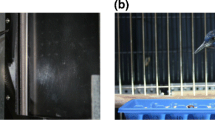Abstract
Models of strictly rational choice assume that decision-makers evaluate options on relevant dimensions, assign fixed values to options, and then make consistent choices based on these values. If so, recent experience would have no impact on preference. But, recent events change an animal’s state, and preference may change accordingly. We explore how state affects willingness to accept greater danger to obtain larger food rewards. We tested how a supplement in state (hoard size) impacts this willingness in gray jays (Perisoreus canadensis). When subsidized, most of the subjects increased their willingness to trade danger for food. Why would they become less cautious when their hoard was increased? Superficially, it might seem prudent to play it safer in response to a subsidy. But imagining fitness as a sigmoid function of state (hoard size) provides a tentative explanation for our counterintuitive finding. Above a threshold hoard size, a subsidy should weaken the willingness to accept extra danger. Incremental increases in state in the deceleratory phase yield smaller fitness gains, so it would pay to increase emphasis on safety after receiving a subsidy. But below this threshold, incremental increases in state in the acceleratory phase yield bigger fitness gains, and so it would pay to decrease emphasis on safety after receiving a subsidy. Most of our subjects’ choice behavior was, thus, plausibly consistent with the possibility that effective hoard size is considerably smaller than the total number of items stored. We speculate that this response may reflect an ecologically rational compensation for the inevitable loss of hoards via theft and rot.

Similar content being viewed by others
References
Bateson M (2002) Context-dependent foraging choices in risk-sensitive starlings. Anim Behav 64:251–260
Bateson M, Healy SD, Hurly TA (2002) Irrational choices in hummingbird foraging behaviour. Anim Behav 63:587–596
Bateson M, Healy SD, Hurly TA (2003) Context-dependent foraging decisions in rufous hummingbirds. Proc R Soc Lond B 270:1271–1276
Benjamini Y, Hochberg Y (1995) Controlling the false discovery rate: a practical and powerful approach to multiple testing. J R Stat Soc B 57:289–300
Houston AI (1997) Natural selection and context-dependent values. Proc R Soc Lond B 264:1539–1541
Hurly TA, Oseen MD (1999) Context-dependent, risk-sensitive foraging preferences in wild rufous hummingbirds. Anim Behav 58:59–66
Kacelnik A, Marsh B (2002) Cost can increase preference in starlings. Anim Behav 63:245–250
Marsh B, Schuck-Paim C, Kacelnik A (2004) Energetic state during learning affects foraging choices in starlings. Behav Ecol 15:396–399
Rice WR (1989) Analyzing tables of statistical tests. Evolution 43:223–225
Roe RM, Busemeyer JR, Townsend JT (2001) Multialternative decision field theory: a dynamic connectionist model of decision making. Psych Rev 108:370–392
Schuck-Paim C, Pompilio L, Kacelnik A (2004) State-dependent decisions cause apparent violations of rationality in animal choice. PLoS Biol 2:2305–2315
Shafir S (1994) Intransitivity of preferences in honey-bees: support for comparative-evaluation of foraging options. Anim Behav 48:55–67
Shafir S, Waite TA, Smith B (2002) Context-dependent violations of rational choice in honeybees (Apis mellifera) and gray jays (Perisoreus canadensis). Behav Ecol Sociobiol 51:180–187
SPSS (2002) SPSS version 11.5. SPSS, Chicago
Stephens DW (2002) Discrimination, discounting and impulsivity: a role for an informational constraint. Phil Trans R Soc B 357:1527–1537
Stephens DW, Anderson D (2001) The adaptive value of preference for immediacy: when shortsighted rules have farsighted consequences. Behav Ecol 12:330–339
Stephens DW, Krebs JR (1986) Foraging theory. Princeton University Press, Princeton
Stephens DW, Kerr B, Fernandez-Juricic E (2004) Impulsiveness without discounting: the ecological rationality hypothesis. Proc R Soc B 271:2459–2465
Stevens JR, Rosati AG, Ross KR, Hauser MD (2005) Will travel for food: spatial discounting in two new world monkeys. Curr Biol 15:1–6
Strickland D, Ouellet H (1993) Gray jay. In: Poole A, Stettenheim P, Gill F (eds) The birds of North America, no. 40. Birds of North America, Philadelphia
Strickland RD, Waite TA (2001) Does initial suppression of allofeeding in small jays help to conceal their nests? Can J Zool 79:2128–2146
Tversky A, Simonson I (1993) Context-dependent preferences. Manage Sci 39:1179–1189
Waite TA (1991) Economics and consequences of scatter-hoarding in gray jays. Dissertation, Ohio State University, Columbus, OH, USA
Waite TA (2001a) Intransitive preferences by hoarding gray jays. Behav Ecol Sociobiol 50:116–121
Waite TA (2001b) Background context and decision making in hoarding gray jays. Behav Ecol 12:318–324
Waite TA, Strickland D (2006) Climate change and the demographic demise of a hoarding bird living on the edge. Proc R Soc B 273:2809–2813
Waite TA, Ydenberg RC (1996) Foraging currencies and the load-size decision of scatter-hoarding grey jays. Anim Behav 51:903–916
Acknowledgment
We thank C. Schuck-Paim, A. Kacelnik, L. Pompilio, and other participants at the Limits to Rationality workshop, held at the Institute for Advanced Study (Wissenschaftskolleg), for inspiring this study; M. Bateson, A. Hurly, and S. Shafir for the discussion; and C. Schuck-Paim and L. Pompilio for comments on an early version of the manuscript. Protocol (00A0148) approved by OSU Institutional Laboratory Animal Care and Use Committee. This study is supported by the OSU Office of Research (Large Interdisciplinary Grant Program), Mathematical Biosciences Institute, and National Science Foundation.
Author information
Authors and Affiliations
Corresponding author
Additional information
Communicated by H. Kokko
Rights and permissions
About this article
Cite this article
Waite, T.A., Nevai, A.L. & Passino, K.M. State subsidies induce gray jays to accept greater danger: an ecologically rational response?. Behav Ecol Sociobiol 61, 1261–1266 (2007). https://doi.org/10.1007/s00265-007-0356-8
Received:
Revised:
Accepted:
Published:
Issue Date:
DOI: https://doi.org/10.1007/s00265-007-0356-8




